Readers, boy, oh boy, do I have a story for you.
This is the type of a-ha moment in sleuthing that Agatha Christie only plots for Poirot. I mean, truly I am so thrilled to unravel this history and provenance behind the heirloom silver pieces Wemple inherited from his late grandmother, the ever-caring, always laughing, for the sake of this article, let us call her Madame P.
Before we tuck into the story of Madame’s silver, we need to run through some 21st & 18th announcements - a lot has been happening.
VintageFinds TV
VintageFinds TV is off to the races, Episode #2 featuring vintage fashion from Bob Mackie and Elinor Simmons for Malcolm Starr aired earlier this week. Watch and subscribe here. Spoiler: This ivory Bob Mackie for Saks Fifth Avenue blazer is for sale. If you would like to inquire or make an appointment to view 21st & 18th’s Vintage Finds Collection, write to us at contact@21stand18th.com.
Art Apéritifs
Our beloved segment where I, LLW, interview museum curators from near and far, returns next week and will feature an interview with Diana Greenwald the William and Lia Poorvu Curator for the Collection at the Isabella Stewart Gardner Museum. Ensure you are subscribed to 21st & 18th to receive this interview direct to your inbox next Friday, 26 January.
LLW Style
If you enjoy reading about style and are looking to shop my looks, see here for my shop-able wardrobe featuring select recent looks.
Reminder: 21st & 18th offers Bridal and Wardrobe styling and vintage sourcing services. Write us to learn more, contact@21stand18th.com.
Calling all Journalists
21st & 18th is opening up certain editorial segments to other voices. Expect fresh voices in the arts & culture space. If you would like to pitch an idea for an article to 21st & 18th write to LLW at lauren@21stand18th.com.
Why are objects important? This is something we talk about often in our segment, Art Apéritifs, with museum curators. The resounding response is that objects are important because humans assign them meaning. Why do we assign meaning to objects? On the whole because they elicit an emotional response in us or we appreciate the maker/sender/creator of said object. Consider this: If objects had no meaning we would have no wedding dresses, inherited jewelry, tattoos or saved invitations or cards. Objects are important to human history and connection.
I collect a lot of objects, but not aimlessly and without strategy but also not for the sake of resale value or worth - I collect objects that make me happy, help me to feel inspired or possess a great memory (typically pertaining to family or a historical figure I admire).
Recently, after the passing of Wemple’s paternal grandmother, Madame P, he received some pieces of silver from her family’s collection. Silver passed down generations and forged in Vienna, Austria, originally for Wemple’s great-grandparents. If you subscribe to 21st & 18th and have been reading my weekly newsletters, you know an inherited gift of any kind that comes into my life is deserving of a good sleuthing - so I set to work.
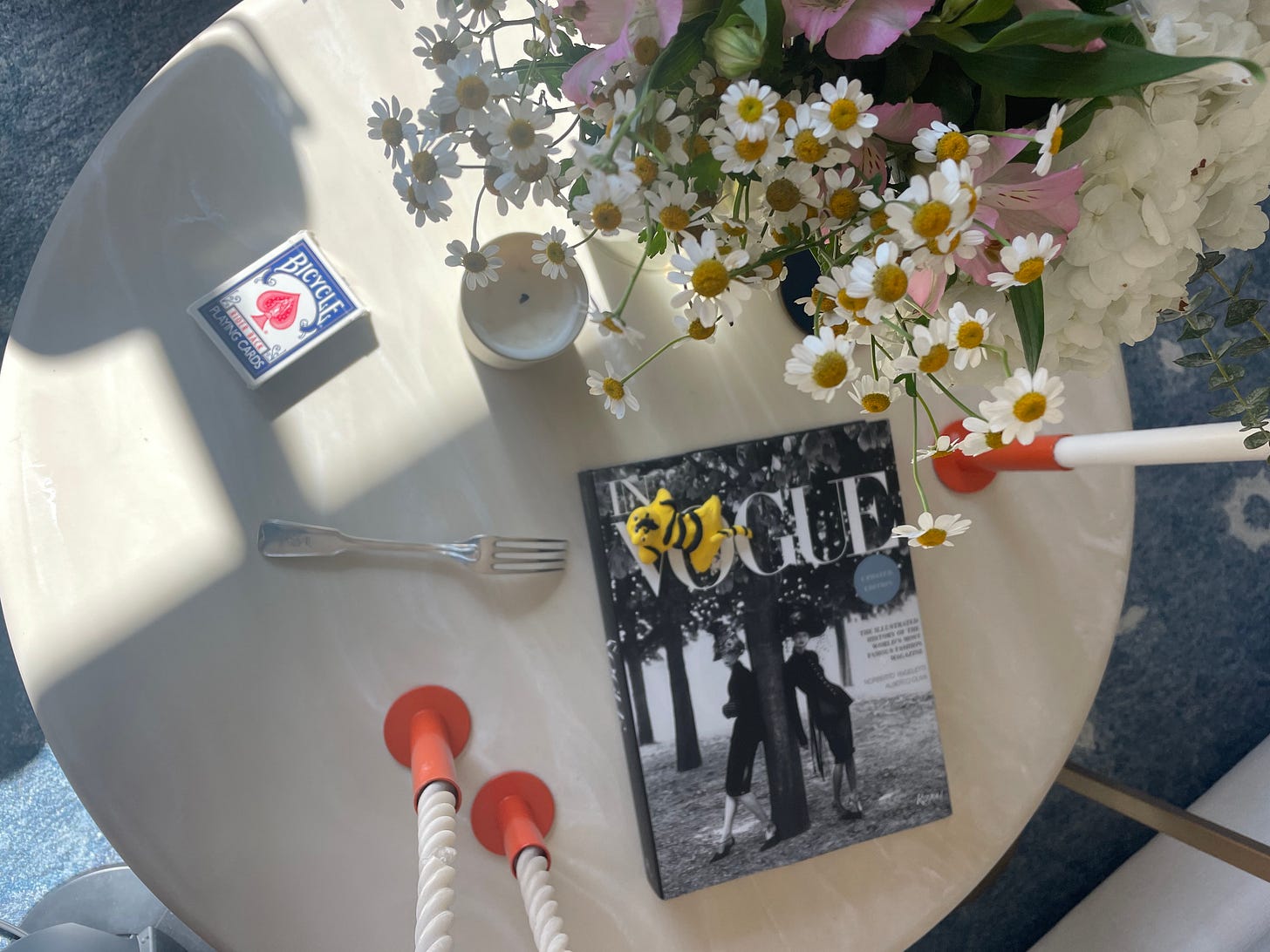
Knowing what I know about Madame P. Wemple, I knew there was a juicy story in this silver. What I didn’t know is how much history a fork, an egg cup, a butter knife contain. Of course there are the people who held and used and washed and polished these pieces but more interestingly, to me, the silversmith, the original maker, left their mark by way of teeny tiny stamps in the metal on the back of each piece. We expect some sort of brand tag, sure. However the fact that 3 little letters, stamped into silver over 100 years ago, before the big bad web and social media and texting, are the gateway to over 16,000 search results is astounding. To put this into perspective, sometimes when I am doing research for 21st & 18th I cannot find 1,000 pieces of information about a still living designer from England who has won awards and dressed celebrities and been featured in magazines1. Sometimes I can’t even uncover additional information from museums and archival institutions on said aforementioned designer - and they are living during this age of technology connectedness! For there to be so much information available about a 19th century silversmith from a small and politically neutral country in Europe, as opposed to a ‘hot’ fashion designer of the 21st century, well, that codifies my original hypothesis, Madame P left us a trail of juicy breadcrumbs to follow.
The year is 1822.
The President of the United States is James Monroe and yes, slavery is about 42 years from being abolished. In the US, Missouri becomes the 24th state in the Union while East and West Florida merge to create the territory of Florida. Among others, Harriet Tubman, born Araminta Ross, and Ulysses S. Grant are both born.
In Austria that same year, the Imperial powers are still going strong with Franz Josef I and Elisabeth (aka Sisi) as Emperor and Empress, Austria is in alliance with Russia and Prussia in a pact referred to as the Holy Alliance, established after the Napoleonic Wars and defeat of Napoleon in Russia, and the main character in this here Vintage Finds article: Josef Carl Klinkosch, is born.
Josef Carl Klinkosch, professionally recognized as JCK, was an Austrian silversmith, revered globally for his work, perhaps we shall say craftsmanship, with the metal. Klinkosch was born into a family of silversmiths and took up the profession of his father, beginning an apprenticeship in 1837 and ‘graduating’ into running the business alongside his father by 1839. Similar to other Viennese craftspeople at the top of their game and profession, cough cough Imperial Vienna Porcelain, JCK was named Court silversmith in 1837, when Klinkosch the younger was just 15 years old, and in 1851, Klinkosch the younger took over the business in full. Under his creative and business leadership, just 4 years later, JCK was given a Royal Warrant from Franz Josef in 1855. During the back half of the 1800s JCK was in its prime, with clients in the highest social echelons of society: aristocrats, royals, wealthy people with taste etc. In 1879 Klinkosch was knighted and his pieces of silver can still be seen today as part of the Austrian Royal collection in Vienna.
Fun fact: These special JCK silver pieces are still used at Austrian state banquets and events today.
21st century LLW is interrupting here. Why are we talking about JCK and all his success? As it happens the heirloom silver from Madame P is JCK silver, dating back to the very early 1900s, perhaps late 1800s.
If you are wondering what happened to JCK after Klinkosch’s knighthood, well, the company continued to grow and expand and hold the title of imperial silversmith - their product was in high demand after Klinkosch’s retirement in 1884 when the company passed to his sons, Arthur and Isidor. In 1918 the business was acquired by Arthur Krupp and operated until the early 1970s. 169 years from receipt of their Royal Warrant, JCK silver pieces remain the best of the best and in globally high demand in 2024.
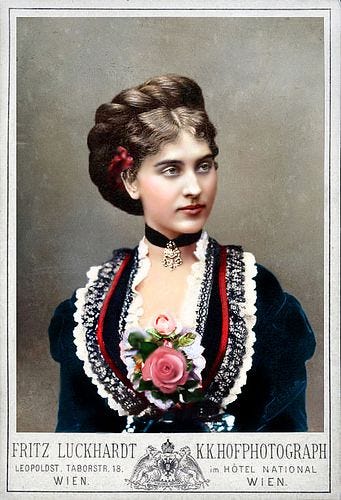
Bringing it back to the present day, these incredible silver pieces, which all made up a family collection, belonged to Wemple’s paternal grandmother. Her family is of Austrian lineage, which of course we knew, and was handsomely positioned within society. This JCK silver would have been used by generations of family members and friends and colleagues and connections and then cleaned and caring-ly stored and moved over decades by those same family members and staff. This silver, without even knowing who JCK is and what their craftsmanship means, is emotionally valuable - it’s Wemple’s history. Personally, I have an innate interest in understanding where I, Wemple, you or another person came from - it helps us better understand our elders, others and ourselves. Again, don’t I always say context is everything?
In this case, let us look into the silver pieces a bit more.
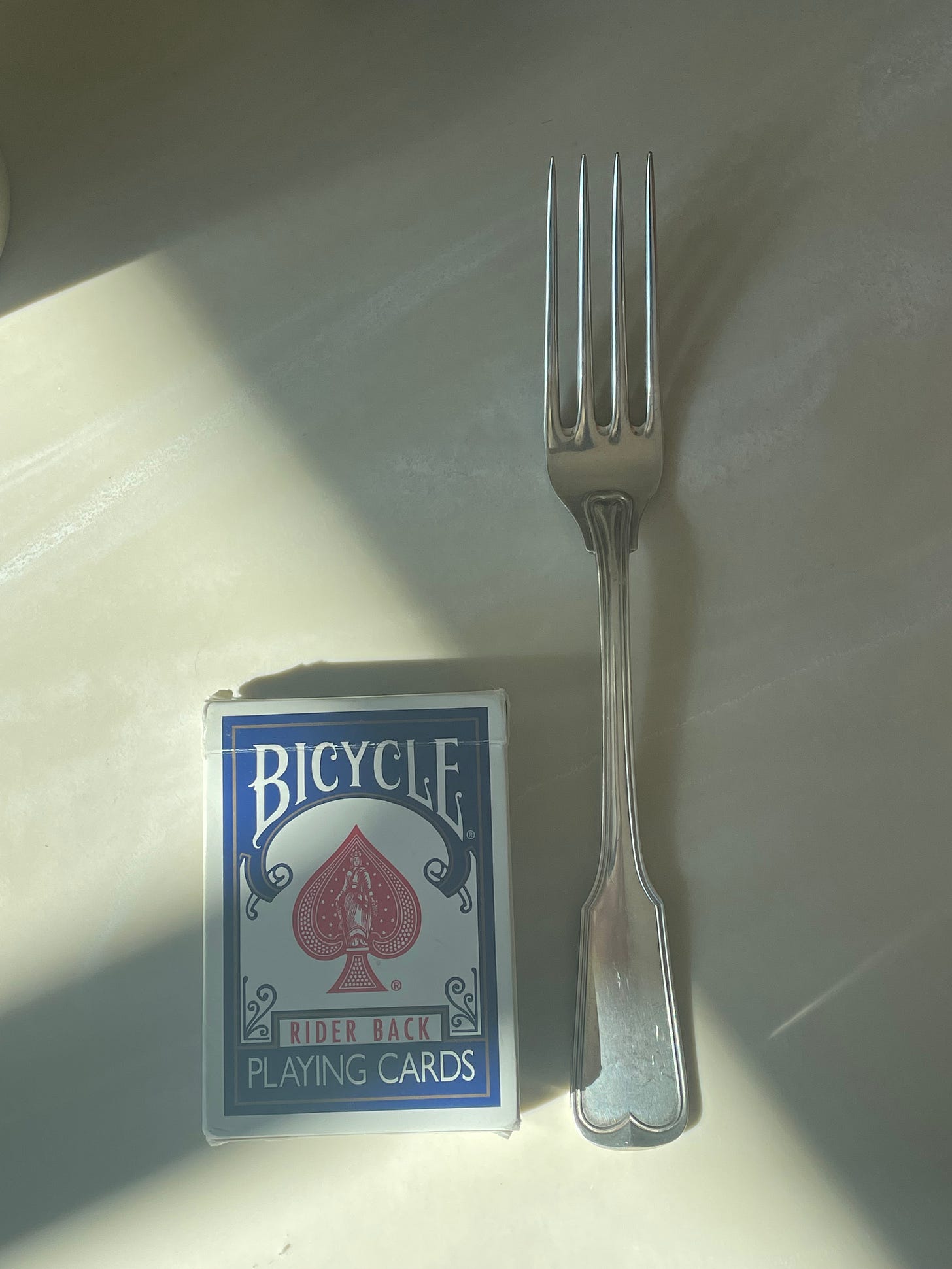
Take this fork. Beautiful, long tines2, longer than we would see on everyday silver flatware, well shaped yet simple and elegant. On the back we see the JCK stamp along with ‘800’, which means the pieces are 80% pure silver alloy, similar to stamps on gold, 14k, 18k etc. Okay, on any well forged or high end silver or gold pieces I expect to see a stamp by the maker or a note on the purity. What else is there?
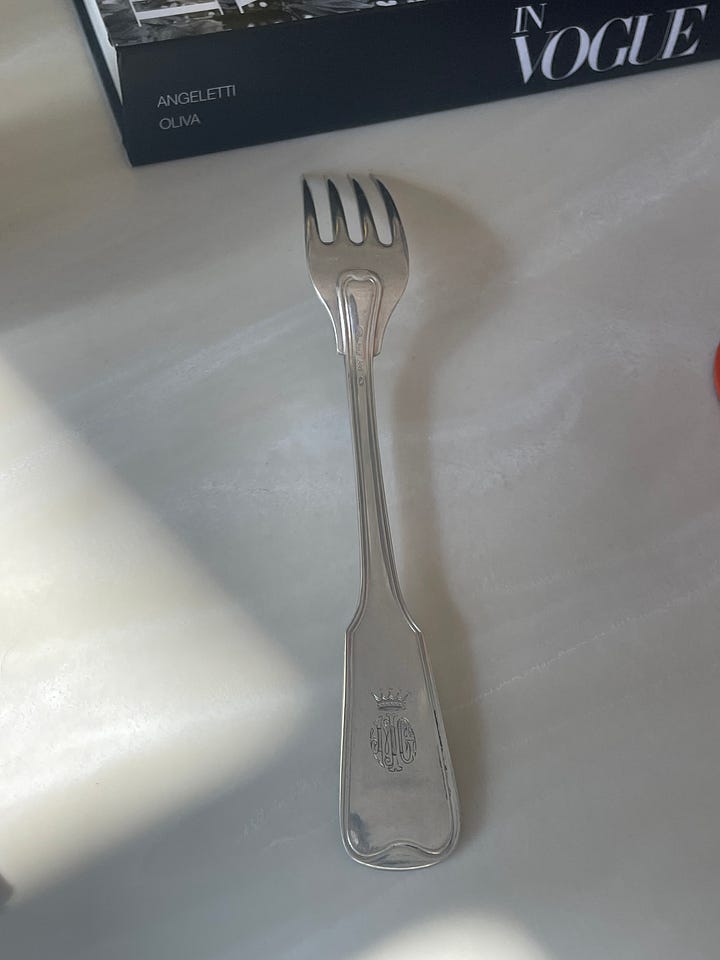
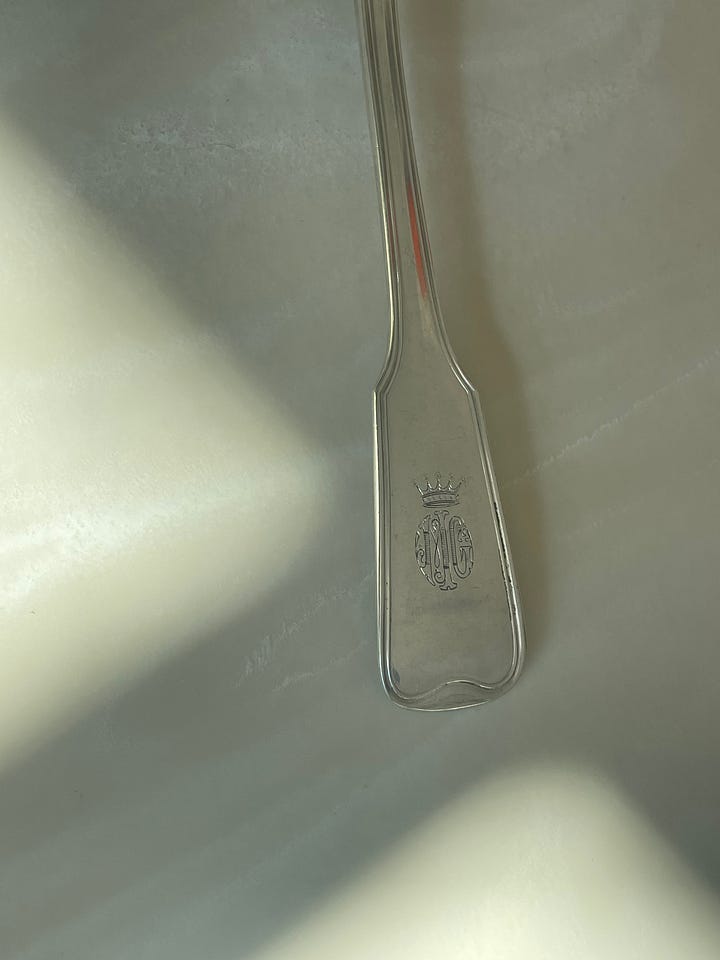
Well, there is the crest. Do you see it? The crown and letters, ‘MG’. This is where it gets very interesting.
Remember when we said that JCK was made Court silversmith in the 1800s, under Emperor Franz Josef I? Well that meant that all those people with titles or connections or of aristocratic lineage were basically given one option for their silver needs: JCK. So it was JCK you went to for candelabras, gravy boats, platters and flatware, and once you had that JCK silver in your possession you marked it, to ensure it was unmistakable who the pieces belonged to - quick reminder, silver sets have LOADS of small pieces, if the pieces are not marked in someway they could be stolen, traded, get lost or find their way into another silver collection and no one would be none the wiser. So these crests, by families who already had titles or noble lineage were part and parcel to the process of a silver commission.
Back to our silver’s crest. Well, the crown is not just any crown, it is a Heraldic Crown, symbolic of the title ‘Edler’ a German title in use until 1919 that was marked with 5 pearls atop its points and symbolizing a noble rank in Austria, Hungary and Germany. Edler ranks above ‘Von’, ie. the Von Trapp family in Sound of Music, and below ‘Ritter’ or a hereditary Knight. This system of noble rankings dates back to Feudal Europe in the Middle Ages, and is similar to the English noble ranking system that is still in place today, ie. Duke, Marquess, Earl, Viscount and so on…
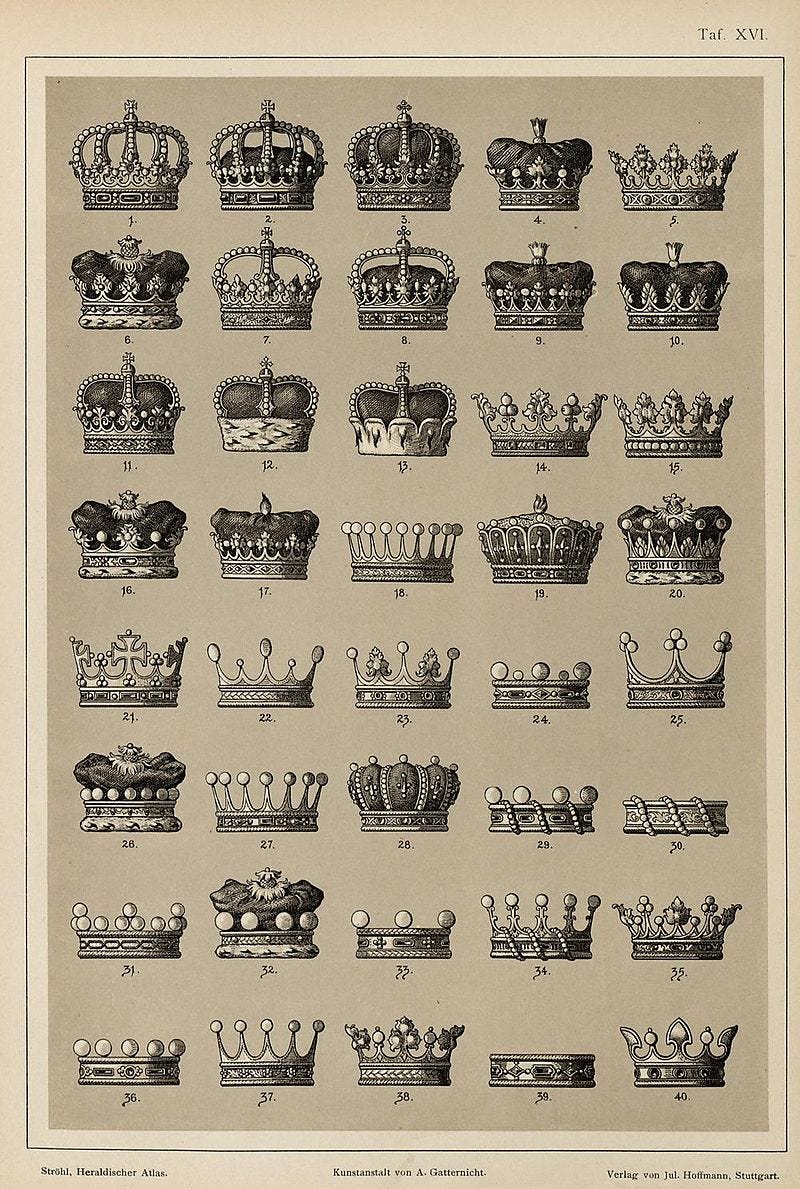
Now, I bet, your brain is moving. And to answer your question, yes, Wemple’s Austrian lineage traces back to nobility. *Pause for a moment of disbelief.*
The initials noted here are those of Wemple’s paternal grandmother’s mother, so his great grandmother - her name was Marie Gebauer when these silver pieces received their inlaid crest. For reference, and to practice your German, her full name was Marie Gebauer Edle von Fülnegg née3 Berl. Another pause.
Wow - that’s incredibly interesting, especially given Elisabeth was Empress during her lifetime (I have an obsession with Sisi but she still doesn’t trump my favorite Austrian royal, Marie Antoinette). More interesting is that MG left Austria during WWII because her family was Jewish and MG and Madame P escaped the atrocities of Hitler’s regime by emigrating to the United States via China.
MG is noted in the United States Holocaust Memorial Museum’s Holocaust Survivors list: See here for reference. Triple, wow.
We won’t go farther into the family story from there. Let us turn back to our Vintage Find: This silver fork. This silver was meaningful, knowing none of its history, but now, does it mean more? Is it more valuable? Yes. Emphatic yes!
Historians know, and perhaps you do too, that studying history is an effective use of your time because history has almost all of the answers. People have made so many mistakes and many of those political, personal, moral, artistic, social, creative mistakes are recorded in history. When we were younger our elders always told us that we could learn from our mistakes, well why not learn from the mistakes of others? That is to me, the power of history. Studying history helps us understand perhaps what not to do and how to combat the effects of corrosive behavior and choices, it encourages us to lead more informed lives. This story, this moment researching Wemple’s family silver, encourages me to record my family history, the fascinating, strong and intelligent people who came before us, their mistakes and triumphs, to pass down to my kids and grandchildren and so on. If we do this, our lineage will be able to learn from the wealth of global history that has already been recorded but also their personal history, and, again, how to better understand yourself than to understand those that came before you? Those whose genetics and features and maybe names you now possess? Powerful.
If you enjoyed this article from 21st & 18th, follow us on Instagram and subscribe below to receive future articles direct to your inbox. If you are a current subscriber, consider becoming a paid Patron and joining 21st & 18th House, a club of culturally curious people who connect offline and receive more musings from me direct to their inboxes.
Until next week - cheers,
LLW
p.s. if you are wondering about the value of JCK silver, these candelabras are on sale for about $20k and this gravy boat approximately 600 GBP in 2011 at Bonham’s auction. (haha, yeah, I know)
This was the case for a recent Vintage Finds article focusing on a pink Catherine Rayner gown
The proper name for the spikes on the fork that we use for spearing yummy things and shoving them into our mouths
French for born, used to denote a woman’s maiden surname







Fascinating find for you, and makes history so much more interesting.